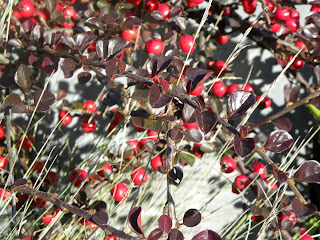Anemone x hybrida 'Robustissima' (Grapeleaf Anemone); this plant attracts wildlife to feed or nest; tolerates heavy clay soils; here the dark pink flowers have gone to seed
In the Floral Hall Courtyard:
Larix kaempferi (Japanese Larch); light green needle-like leaves turn bright yellow to orange before dropping in fall so that the shoots are left bare until spring

In the West View Terrace:
Bergenia purpurascens (Winter-red Bergenia) with Itea virginica 'Little Henry' (Sweetspire); Bergenia is incredibly hardy and reliably evergreen, excellent deep red fall and winter colour; the Itea (on the left) has already dropped its blood red autumn foliage

Bergenia purpurascens (Winter-red Bergenia) with Itea virginica 'Little Henry' (Sweetspire); Bergenia is incredibly hardy and reliably evergreen, excellent deep red fall and winter colour; the Itea (on the left) has already dropped its blood red autumn foliage

In the Floral Hall Courtyard:
Prunus maackii (Manchurian Cherry/Amur Chokecherry); a four-season tree for northern gardens, with lemon yellow fall colour; once leaves have dropped the bark holds its own a rich bronze to cinnamon colour, sometimes peeling like birch, and is stunning in winter
In the Entry Garden:
Molinia caerulea 'Moorhexe' (Moor Grass); attractive form and foliage for year-round interest, strongly vertical architectural flower spikes with great winter colour
Molinia caerulea 'Moorhexe' (Moor Grass); attractive form and foliage for year-round interest, strongly vertical architectural flower spikes with great winter colour













